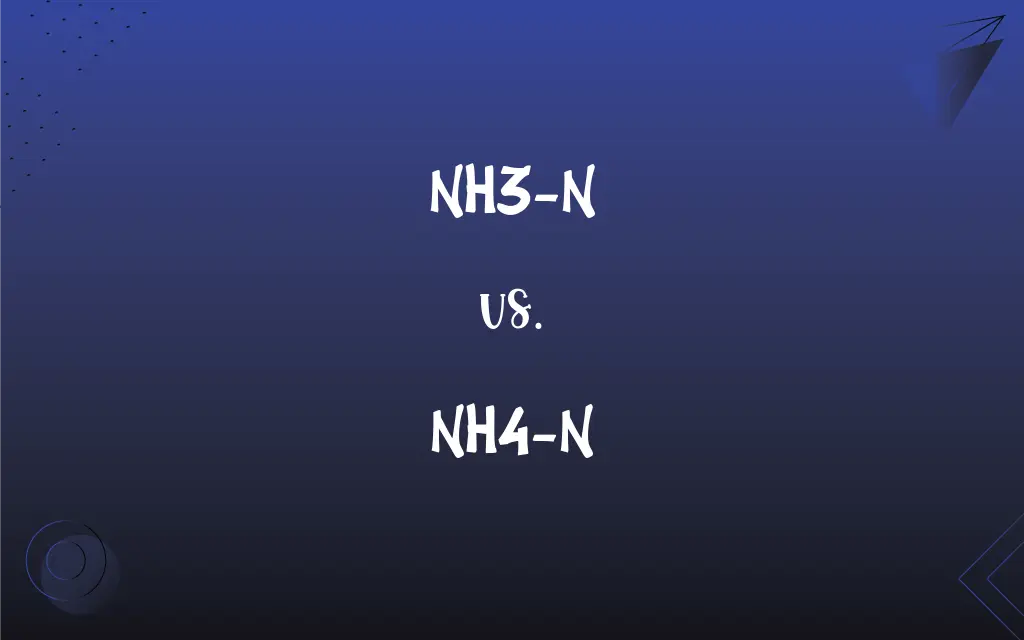NH3-N vs. NH4-N: What's the Difference?
By Janet White & Harlon Moss || Published on March 4, 2024
NH3-N refers to the nitrogen component of ammonia, a toxic gas at high concentrations, while NH4-N represents the nitrogen in ammonium, a stable, non-volatile ion found in water.

Key Differences
NH3-N and NH4-N are both measures of nitrogen, but they represent different forms of nitrogen found in environmental samples. NH3-N (ammonia nitrogen) indicates the amount of nitrogen tied up in ammonia molecules, which are uncharged and can be toxic to aquatic life at high concentrations. This form is prevalent in alkaline conditions. In contrast, NH4-N (ammonium nitrogen) points to the nitrogen within ammonium ions, which carry a positive charge and are more stable and less toxic, especially in acidic to neutral pH conditions.
The balance between NH3-N and NH4-N in water depends heavily on the pH and temperature of the environment. In more alkaline conditions, NH3-N becomes the dominant form, while in acidic conditions, NH4-N is more prevalent. This equilibrium is crucial for water treatment processes and aquatic ecosystems, as it affects both the toxicity of the environment and the availability of nitrogen for biological processes.
From a treatment perspective, understanding the ratio of NH3-N to NH4-N is essential in wastewater treatment plants. Ammonia (NH3-N) needs to be converted into less harmful substances through nitrification, a process where bacteria convert NH3-N first into nitrite (NO2-) and then into nitrate (NO3-). This transformation is critical for reducing toxicity and preparing the water for further treatment or release back into the environment.
In terms of environmental impact, NH3-N can volatilize and enter the atmosphere, where it can contribute to air pollution and the formation of particulate matter. Meanwhile, NH4-N, being more stable, remains dissolved in water and can be utilized by aquatic plants and microorganisms as a nutrient source, although excessive amounts can lead to eutrophication.
Both forms are key indicators in water quality assessment. Measuring NH3-N and NH4-N helps in evaluating the potential impact on aquatic life, the effectiveness of water treatment processes, and the overall health of an aquatic ecosystem.
ADVERTISEMENT
Comparison Chart
Form
Uncharged ammonia molecule
Ammonium ion with a positive charge
Environmental Presence
More prevalent in alkaline conditions
More common in acidic to neutral conditions
Toxicity
High, especially to aquatic life
Lower, less toxic to aquatic life
Stability
Volatile, can escape into the atmosphere
Non-volatile, remains in water
Role in Water Treatment
Needs conversion to less harmful forms
Utilized by plants/microorganisms, can lead to eutrophication if excessive
ADVERTISEMENT
NH3-N and NH4-N Definitions
NH3-N
Its concentration is pH-dependent.
As pH rises, NH3-N levels increase.
NH4-N
It's prevalent in more acidic waters.
Lower pH levels result in higher NH4-N concentrations.
NH3-N
It's more volatile and can contribute to air quality issues.
High NH3-N concentrations can increase atmospheric ammonia.
NH4-N
NH4-N can lead to eutrophication if levels are excessive.
Excessive NH4-N in lakes can cause algal blooms.
NH3-N
NH3-N represents the nitrogen in ammonia, a gas that can be toxic to fish.
Elevated NH3-N levels in a pond can harm aquatic life.
NH4-N
Monitoring NH4-N is crucial for managing water quality.
Water treatment plants adjust processes based on NH4-N levels.
NH3-N
NH3-N requires careful monitoring in environmental assessments.
Water quality tests often measure NH3-N to gauge pollution levels.
NH4-N
Its stability makes it a key nutrient in aquatic ecosystems.
NH4-N is utilized by microorganisms for growth.
NH3-N
NH3-N's presence is a concern in wastewater treatment.
Removing NH3-N is a primary goal in water treatment processes.
NH4-N
NH4-N signifies the nitrogen in ammonium, less toxic and more stable in water.
NH4-N is a major nutrient for aquatic plants.
FAQs
Can NH3-N and NH4-N transform into each other?
Yes, NH3-N and NH4-N can convert into each other depending on environmental conditions like pH and temperature, maintaining a dynamic equilibrium.
What is NH4-N?
NH4-N represents the portion of nitrogen found in ammonium (NH4+), a non-volatile, positively charged ion that is less toxic to aquatic life.
How do pH levels affect NH3-N and NH4-N?
pH levels significantly influence the equilibrium between NH3-N and NH4-N; higher pH favors NH3-N, while lower pH increases NH4-N concentrations.
Why is the distinction between NH3-N and NH4-N important in water treatment?
Understanding the balance between NH3-N and NH4-N is crucial for effective water treatment, as it informs the necessary processes to reduce toxicity and prevent environmental harm.
How are NH3-N and NH4-N measured in water?
Both forms are measured using specific chemical and biological assays that distinguish between the different forms of nitrogen.
What happens to NH3-N and NH4-N in wastewater treatment plants?
NH3-N is typically converted to nitrate (NO3-) through biological nitrification, while NH4-N can be directly utilized by plants or also converted in the nitrification process.
What role does temperature play in the NH3-N/NH4-N equilibrium?
Temperature affects the equilibrium, with higher temperatures favoring the formation of NH3-N from NH4-N.
What preventive measures can reduce NH3-N levels in water bodies?
Effective wastewater treatment, reducing agricultural runoff, and maintaining proper aquatic system pH can help minimize NH3-N levels.
How can NH4-N be beneficial to plants?
NH4-N serves as a vital nutrient for aquatic plants and algae, supporting their growth and development.
What are the environmental impacts of NH3-N and NH4-N?
NH3-N can contribute to air and water pollution and is harmful to aquatic life, while NH4-N can lead to nutrient overload and eutrophication in water bodies.
What is NH3-N?
NH3-N refers to the portion of nitrogen (N) present in the form of ammonia (NH3), a toxic, gaseous form of nitrogen in water.
What is the significance of the NH3-N to NH4-N ratio in water quality assessment?
The ratio provides insights into the water's chemical balance, potential toxicity, and the effectiveness of nitrogen removal processes.
Can NH3-N contribute to eutrophication?
Yes, although NH4-N is more commonly linked to eutrophication, NH3-N can also contribute to nutrient overloading in water bodies, fostering excessive algae growth.
How do environmental regulations address NH3-N and NH4-N?
Regulations often set maximum allowable concentrations for both forms to protect water quality and aquatic life, varying by jurisdiction.
How do changes in water temperature affect the NH3-N/NH4-N equilibrium?
Increased temperatures shift the equilibrium towards more NH3-N due to increased molecular motion and reduced solubility of gases in water.
What techniques are used to convert NH3-N to less harmful forms in treatment plants?
Biological nitrification, where bacteria convert NH3-N to nitrite and then to nitrate, and chemical treatment methods are commonly used.
What are some challenges in managing NH3-N and NH4-N in agricultural runoff?
Challenges include controlling the amount of nitrogen fertilizer application, preventing over-irrigation, and implementing runoff management practices to reduce nitrogen entry into water bodies.
Why is it important to monitor NH3-N and NH4-N levels in environmental water?
Monitoring these levels is crucial for assessing water quality, protecting aquatic life, and ensuring effective water treatment processes.
How does the presence of NH3-N affect aquatic animals?
NH3-N, being toxic, can lead to physiological stress, harm, or even death in aquatic animals, especially at high concentrations.
What role does the temperature play in the biological treatment of NH3-N?
Temperature influences the activity of nitrifying bacteria; higher temperatures generally increase their activity, enhancing the conversion rate of NH3-N to nitrate.
About Author
Written by
Janet WhiteJanet White has been an esteemed writer and blogger for Difference Wiki. Holding a Master's degree in Science and Medical Journalism from the prestigious Boston University, she has consistently demonstrated her expertise and passion for her field. When she's not immersed in her work, Janet relishes her time exercising, delving into a good book, and cherishing moments with friends and family.
Co-written by
Harlon MossHarlon is a seasoned quality moderator and accomplished content writer for Difference Wiki. An alumnus of the prestigious University of California, he earned his degree in Computer Science. Leveraging his academic background, Harlon brings a meticulous and informed perspective to his work, ensuring content accuracy and excellence.































































